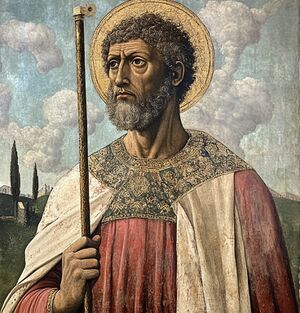Romaian art: Difference between revisions
(Created page with "thumb|[[ Petros Eleftherios's ''Agios Petros'' is a Romaian art masterpiece worldwide famous.]] Romaian culture has developed over millennia, originating in the Ancient Hellenic city-states of Romaia and later significantly shaped by the Italic culture during the period of Ancient Romaia. The cultural landscape of Romaia has also been influenced by other civilizations, including the Ancient Celtic states, Persians, and Haramounians. Despite thes...") |
No edit summary |
||
| Line 1: | Line 1: | ||
{{WIP}} | |||
[[File:Stpaul.jpeg|thumb|[[ Petros Eleftherios]]'s ''[[Agios Petros]]'' is a Romaian art masterpiece worldwide famous.]] | [[File:Stpaul.jpeg|thumb|[[ Petros Eleftherios]]'s ''[[Agios Petros]]'' is a Romaian art masterpiece worldwide famous.]] | ||
{{Culture of Romaia}} | |||
Romaian culture has developed over millennia, originating in the Ancient Hellenic city-states of Romaia and later significantly shaped by the Italic culture during the period of Ancient Romaia. The cultural landscape of Romaia has also been influenced by other civilizations, including the Ancient Celtic states, Persians, and Haramounians. Despite these diverse influences, historians attribute the Romaian Unification as a pivotal moment that revitalized [[Romaia]], leading to the emergence of a unified and cohesive cultural identity. | Romaian culture has developed over millennia, originating in the Ancient Hellenic city-states of Romaia and later significantly shaped by the Italic culture during the period of Ancient Romaia. The cultural landscape of Romaia has also been influenced by other civilizations, including the Ancient Celtic states, Persians, and Haramounians. Despite these diverse influences, historians attribute the Romaian Unification as a pivotal moment that revitalized [[Romaia]], leading to the emergence of a unified and cohesive cultural identity. | ||
| Line 6: | Line 11: | ||
Romaian art has played a significant role in shaping various major artistic movements throughout history and has produced numerous renowned painters, architects, and sculptors. In the present day, Romaia maintains a prominent position in the international art scene, boasting several major art galleries, museums, and exhibitions. Key artistic centers within the country include [[Constantinoupoli]], Sebastoupoli, Nauplia, [[Nikaia]], Adras, Salona, and other cities. | Romaian art has played a significant role in shaping various major artistic movements throughout history and has produced numerous renowned painters, architects, and sculptors. In the present day, Romaia maintains a prominent position in the international art scene, boasting several major art galleries, museums, and exhibitions. Key artistic centers within the country include [[Constantinoupoli]], Sebastoupoli, Nauplia, [[Nikaia]], Adras, Salona, and other cities. | ||
== Ancient Era == | |||
== Medieval Art == | |||
== Anagennisi Art == | |||
{{Romaia_topics}} | {{Romaia_topics}} | ||
Revision as of 10:06, 23 August 2024
This article is incomplete because it is pending further input from participants, or it is a work-in-progress by one author. Please comment on this article's talk page to share your input, comments and questions. Note: To contribute to this article, you may need to seek help from the author(s) of this page. |
| Part of a series on the |
| Culture of Romaia |
|---|
 |
| History |
| People |
| Languages |
| Mythology |
| Cuisine |
| Festivals |
| Religion |
| Art |
| Literature |
Romaian culture has developed over millennia, originating in the Ancient Hellenic city-states of Romaia and later significantly shaped by the Italic culture during the period of Ancient Romaia. The cultural landscape of Romaia has also been influenced by other civilizations, including the Ancient Celtic states, Persians, and Haramounians. Despite these diverse influences, historians attribute the Romaian Unification as a pivotal moment that revitalized Romaia, leading to the emergence of a unified and cohesive cultural identity.
Since ancient times, the regions of western, central, and northern Romaia have been inhabited by various civilizations, including the Minoans, Etruscans, and Kartvelians. Over time, Ancient Romaia emerged as the dominant power in both Romaian and Eulabian territories. The remnants of Ancient Hellenic and Romaian civilizations within Romaia are remarkably rich, ranging from the grand Imperial monuments of Constantinoupoli to the exceptionally well-preserved ordinary structures found in Palaichori and nearby sites. After the fall of the Empire, Romaia continued to be a significant center for Romaian art during the Middle Ages, with Nikaia and other sites playing key roles. The Chandic school in Romaia also contributed to the development of the Vitulian and Romaian Renaissance.
Romaian art has played a significant role in shaping various major artistic movements throughout history and has produced numerous renowned painters, architects, and sculptors. In the present day, Romaia maintains a prominent position in the international art scene, boasting several major art galleries, museums, and exhibitions. Key artistic centers within the country include Constantinoupoli, Sebastoupoli, Nauplia, Nikaia, Adras, Salona, and other cities.
